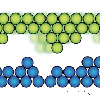| Jul 25, 2022 |
|
(Nanowerk News) For machines with mechanical elements, friction is an unavoidable enemy. It is a major source of service failure and can reduce the lifespan of any machinery, from bicycles and cars to airplanes and assembly lines.
|
|
New research led by the University of Pittsburgh unveils the atomic-scale friction of a single tungsten asperity, or rough edge, in real time, showing atomic motion for the first time with electron microscopy. The work, completed by two labs in the Swanson School of Engineering, was recently published in the journal Nature Nanotechnology (“Atomic-scale friction between single-asperity contacts unveiled through in situ transmission electron microscopy”).
|
|
“Until now, no one has been able to actually see the atomically resolved friction process with a clear-cut interface, so the relationship between the friction mechanisms and the interface hasn’t been fully understood,” said Guofeng Wang, CNG Faculty Fellow and professor of mechanical engineering and materials science, whose lab collaborated on this work. ”In this study, we were able to actually see the sliding pathway of interface atoms and the dynamic strain and stress evolution on the interface that has only previously been shown by simulations.”
|
|
Wang’s group collaborated with now-retired John Swanson Endowed Professor Scott X. Mao’s research group in the Swanson School to provide the first visualization of friction at the atomic scale. Using a high-resolution transmission electron microscope, Mao’s group was able to actually view the movement of atoms across the surface when two surfaces made contact and moved. Wang’s group was then able to use their computer simulations to verify what the microscopic visualizations showed and understand more about the forces at play.
|
|
Though this study focused on tungsten atoms because of their high resistance to the microscope’s heat, the method can be applied to any material to understand friction and wear.
|
|
“What we found is that no matter how smooth and clean the surface is, friction still occurs at the atomic level. It’s completely unavoidable,” said Wang. “However, this knowledge can lead to better lubricants and materials to minimize friction and wear as much as possible, extending the life of mechanical systems.”
|
